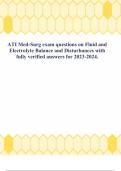ATI Med-Surg exam questions on Fluid and
Electrolyte Balance and Disturbances with
fully verified answers for 2023-2024.
, ATI Med-Surg exam questions on Fluid and
Electrolyte Balance and Disturbances with
fully verified answers for 2023-2024.
Solution Guide
Question 1: An elderly patient is prescribed 40 mg of Lasix twice
daily. What is the most severe electrolyte imbalance that can result
from this diuretic use? Correct answer: Hypokalemia Explanation:
Hypokalemia (potassium level below 3.5 mEq/L) typically signifies
a reduction in total potassium levels. Potassium-wasting diuretics,
like loop diuretics, often lead to hypokalemia. Reference: Hinkle,
J.L., and Cheever, K.H., Brunner & Suddarth's Textbook of
Medical-Surgical Nursing, 13th edition, p. 255.
Question 2: A nurse is assessing a patient's lab results to identify
critical values that need to be reported to the physician. Which
value requires immediate action? Correct answer: Potassium: 5.8
mEq/L Explanation: The normal potassium range is 3.5 to 5.5
mEq/L. Elevated potassium levels can cause muscle weakness,
tingling sensations, and heart rhythm problems. Reference: Hinkle,
J.L., and Cheever, K.H., Brunner & Suddarth's Textbook of
Medical-Surgical Nursing, 13th edition, p. 254.
Question 3: A patient with pancreatic cancer has a blood chemistry
profile showing: Glucose: 204 mg/dL, BUN: 12 mg/dL, Creatinine:
0.9 mg/dL, Sodium: 136 mEq/L, Potassium: 2.2 mEq/L, Chloride:
99 mEq/L, CO2: 33 mEq/L. Which value should be identified as
critical and reported immediately? Correct answer: Potassium
Explanation: A potassium level of 2.2 mEq/L is critically low since
the normal range is 3.8 to 5.5 mEq/L. Severe hypokalemia can lead
to cardiac and respiratory arrest. Elevated glucose and slightly low
chloride levels should be noted but are not life-threatening.
Reference: Hinkle, J.L., and Cheever, K.H., Brunner & Suddarth's
Textbook of Medical-Surgical Nursing, 13th edition, p. 255.
, Question 4: Which nerve is associated with Chvostek’s sign?
Correct answer: Facial nerve Explanation: Chvostek’s sign involves
muscle twitching when the facial nerve is tapped about 2 cm in
front of the earlobe, just below the cheekbone. Reference: Hinkle,
J.L., and Cheever, K.H., Brunner & Suddarth's Textbook of
Medical-Surgical Nursing, 13th edition, p. 259.
Question 5: A client has arterial blood gas (ABG) values of pH 7.12, PaCO2
40 mm Hg, and bicarbonate (HCO3–) 15 mEq/L. Which disorder do these
values indicate? Correct answer: Metabolic acidosis Explanation: The low pH
suggests acidosis, and the low bicarbonate level indicates an excess of acids
or loss of base, which points to metabolic acidosis. Normal PaCO2 means no
respiratory compensation is present, ruling out other disorders. Reference:
Hinkle, J.L., and Cheever, K.H., Brunner & Suddarth's Textbook of Medical-
Surgical Nursing, 13th edition, p. 268.
Question 6: The nurse is caring for a client with lab results indicating
dehydration. What is a consistent clinical symptom of dehydration? Correct
answer: Dark, concentrated urine Explanation: Dark, concentrated urine
suggests a fluid volume deficit. Increasing fluid intake would dilute the urine,
indicating improved hydration. Reference: Hinkle, J.L., and Cheever, K.H.,
Brunner & Suddarth's Textbook of Medical-Surgical Nursing, 13th edition, p.
246.
Question 7: How does the body typically respond to decreased fluid volume
(hypovolemia)? Correct answer: Tachycardia Explanation: Hypovolemia, or
fluid volume deficit, leads to signs like decreased urine output, rapid heart
rate, vasoconstriction, cool skin, and muscle weakness. The nurse should
watch for a quick, weak pulse and low blood pressure. Reference: Hinkle, J.L.,
and Cheever, K.H., Brunner & Suddarth's Textbook of Medical-Surgical
Nursing, 13th edition, pp. 245-246.
Question 8: What clinical symptom should a nurse monitor for in a patient with
a possible air embolism from IV therapy? Correct answer: Chest pain
Explanation: Symptoms of an air embolism include difficulty breathing, low
blood pressure, rapid weak pulse, loss of consciousness, and pain in the
chest, shoulder, or lower back. Reference: Hinkle, J.L., and Cheever, K.H.,
Brunner & Suddarth's Textbook of Medical-Surgical Nursing, 13th edition, p.
280.
Question 9: Which ABG values indicate respiratory acidosis in a patient with
severe pneumonia? Correct answer: pH: 7.20, PaCO2: 65 mm Hg, HCO3–:
26 mEq/L Explanation: Respiratory acidosis is identified when pH is below
7.35 and PaCO2 is above 42 mm Hg, with a compensatory rise in bicarbonate
levels. Reference: Hinkle, J.L., and Cheever, K.H., Brunner & Suddarth's
Textbook of Medical-Surgical Nursing, 13th edition, p. 269.
Question 10: At what serum sodium level might convulsions or coma occur?
Correct answer: Below 135 mEq/L Explanation: Hyponatremia occurs when
sodium levels drop below 135 mEq/L. Severe deficits can cause symptoms
like confusion, muscle weakness, and in extreme cases, convulsions or coma.
Reference: Hinkle, J.L., and Cheever, K.H., Brunner & Suddarth's Textbook of
Medical-Surgical Nursing, 13th edition, p. 253.




